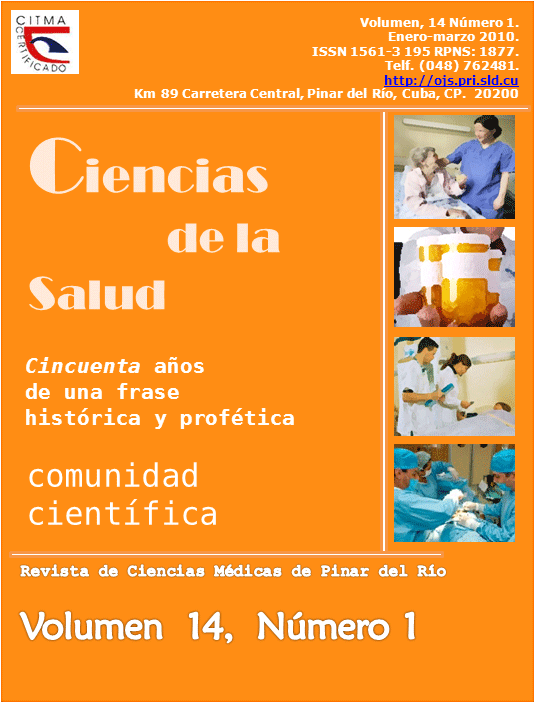Clinical-epidemiological behavior of diving accidents at "Maria la Gorda" International Diving Center, Pinar del Río
Abstract
Diving is a sports, recreational, safe, and studied activity having risks of any other. The results of a descriptive, observation, and cross-sectional research was conducted with a sample comprised of all the divers that suffered any kind of diving accident at "Maria la Gorda" International Diving Center, Pinar del Rio, during 2007-2008. The information was recorded in a statistical database system (STATISTIC), which allowed applying detailed estimates of relative frequencies to the descriptive-statistical analysis of the results. Chi square test and its variants of contingency table, as well as the hypothesis to compare the corresponding ratios to the mutual exclusive category were used. Male sex and the age bracket of 30 to 39 prevailed. The most frequent diving accidents were: barotraumas of the ear having no significant differences regarding sex. Older ages than 45 and female sex were the most predisposing factors that affected the sample taken. The most affected category of divers was: nonprofessionals, followed by sports and professionals without significant statistical differences. The majority of the accidents were not fatal.Downloads
References
1. Ávila L. Por debajo de la cota cero. 4th ed. España: Editorial Hispana Europea; 2007.p.251-257.
2. Venéreo E. Actuación Inicial en Accidentes disbáricos de buceo. Rev. Cubana Med Mil. 2005; 20 (1): 12-17.
3. Desola Ala J. Accidentes de buceo (2). Barotrauma respiratorio: Síndrome de Soprepresión Pulmonar.Med. Clin. (en prensa). Barcelona.;2008.
4. Huertos J, Rodríguez JC, Saldaña F. Ahogamiento y casi ahogamiento. En: Principios de Urgencias, Emergencias y Cuidados Críticos Editorial Aulia; Lima.Perú; 2007.Pp.1067.
5. A Abella C, García-Sanpedro A. Accidentes disbáricos de buceo en Catalunya. Revisión del período 1967-1995. Estudio prospectivo. Med Clin Barcelona; 1977.Pp.15-20.
6. Álvarez JA. Análisis de algunos aspectos estadísticos de los reportes de accidentes de buceo en el CEMAS desde los años 1990-2006. Rev. Cubana Med Mil. 2007; 25 (1): 27-30.
7. West BJ, Griffin LA, Frederick HJ, Moon RE. The independently fractal nature of respiration and heart rate during exercise under normobaric and hyperbaric conditions. Respir Physiol Neurobiol. 2008; 145:219-233.
8. Catron,P. W.;Flynn,E.T.:Adjuvant drug therapy for decompression sickness: a review. Undersea Biomed Res.2006; 9 (2): 161-74.
9. Denoble PJ, Vann RD, Bennett PB, Marroni A. Ten years of prospective studies in recreational diving. Undersea Hyperb Med.2004; 31(3): 308-309.
10. Dionisio Montón Rapall: Oxygenation Hyperbarica. Hospital de Sao Pablo, Barcelona; 2006.
11. Moon RE, Longphre JM. Diving. In: Laurent GJ, Shapiro SD, eds. Encyclopedia of Respiratory Medicine. San Diego, CA: Academic Press; 2006.Pp.21-29.
12. Elliot DH, Moon RE. Manifestations of the decompression disorders. En: Bennett PB, Elliot DH. The Physiology and Medicine of Diving. 4th ed. London: WB Saunders Company Ltd; 2007.Pp.267-300.
13. Mulrooney P. Aeromedical patient transfer. Brit J Hosp Med. 2005; 45:209-211.
14. Moon RE. Pathophysiology of decompression illness. Divers Alert Network Web-Based Training Program. [Sitio en Internet] 2007 [acceso 20 de Julio 2008] Disponible en: http://www.diversalertnetwork.org/training/seminars/pathophysiology/index.asp
15. Pérez Hidalgo I. Preparación del paciente para evacuaciones aéreas. Emergencias[revista en internet]. Febrero 1997[citado]; 9(1): Disponible en: http://www.semes.org/revista/vol09_1/35-43.pdf
16. Dear GD, Freiberger JJ, Denoble PJ, Uguccioni DM, Moon RE, Vann RD et al. Older divers and outcomes after the treatment of decompression illness. Undersea Hyperb Med. 2006; 33:358.
17. Desola J; Garcia A. Arterial pressure variations in patients undergoing hyperbaric oxygen therapy. En Marroni, ed. Proc 13 th Meeting Hyp Med, 381-5, Palermo; 1987.
18. López Artimiras X, Palomer J,Borras J. Explaining the unexplained dysbaric sport diving accident. En: Ornhagen H., ed.Proceedings of the 11 Meeting of the EUBS,Goteborg; 200.Pp.93-8.
Published
How to Cite
Issue
Section
License
Authors who have publications with this journal agree to the following terms: Authors will retain their copyrights and grant the journal the right of first publication of their work, which will be publication of their work, which will be simultaneously subject to the Creative Commons Attribution License (CC-BY-NC 4.0) that allows third parties to share the work as long as its author and first publication in this journal are indicated.
Authors may adopt other non-exclusive license agreements for distribution of the published version of the work (e.g.: deposit it in an institutional telematic archive or publish it in a volume). Likewise, and according to the recommendations of the Medical Sciences Editorial (ECIMED), authors must declare in each article their contribution according to the CRediT taxonomy (contributor roles). This taxonomy includes 14 roles, which can be used to represent the tasks typically performed by contributors in scientific academic production. It should be consulted in monograph) whenever initial publication in this journal is indicated. Authors are allowed and encouraged to disseminate their work through the Internet (e.g., in institutional telematic archives or on their web page) before and during the submission process, which may produce interesting exchanges and increase citations of the published work. (See The effect of open access). https://casrai.org/credit/



